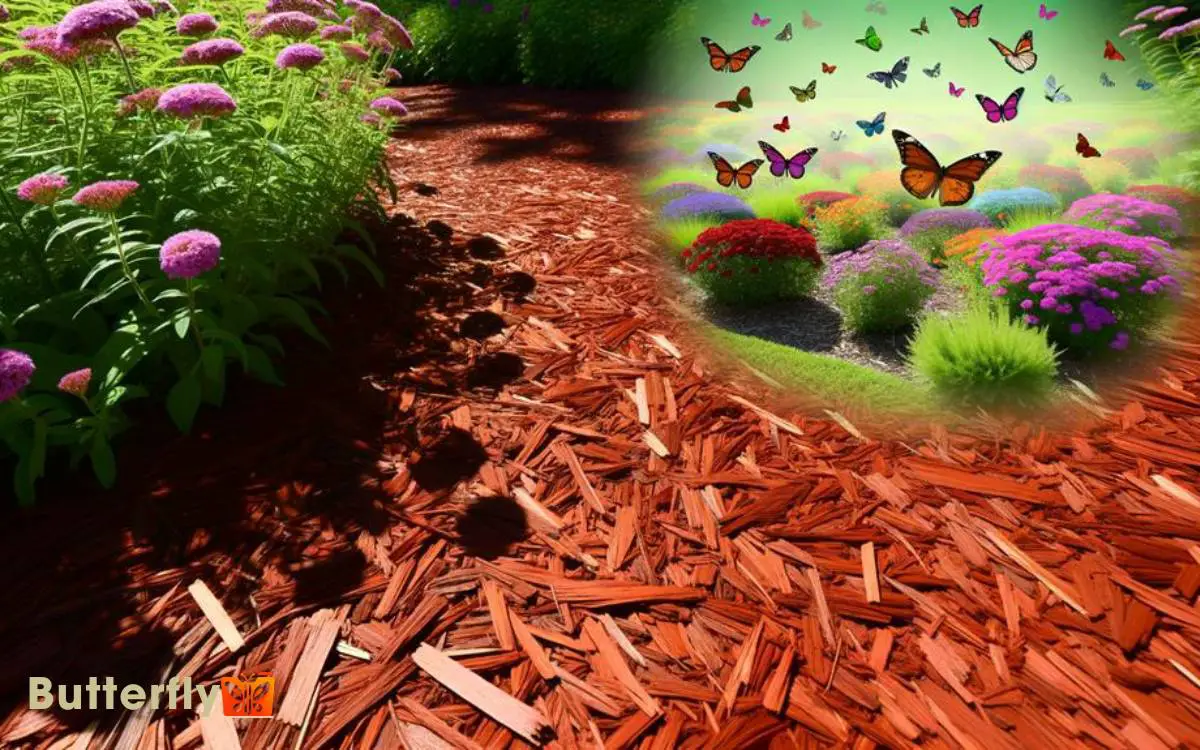Does Cedar Mulch Repel Butterflies? Yes!
Scientific studies show that thujone has neurotoxic effects that impact foraging and mating. While cedar mulch effectively deters pests, its influence on butterflies necessitates careful consideration.
Anecdotal evidence also suggests fewer butterfly sightings in areas with cedar mulch. If you’re curious about more nuanced impacts and potential alternatives, there’s a lot to discover.

Key Takeaways
Understanding Cedar Mulch
Cedar mulch, derived from the wood of cedar trees, is widely valued for its natural aromatic properties and its ability to suppress weed growth.
When you use cedar mulch, you benefit from its high concentration of essential oils, which contribute to its distinctive scent.
These oils, primarily thujone, have been scientifically shown to possess antifungal and insect-repellent properties.
Properties of Cedar Mulch
The unique combination of essential oils in cedar mulch, such as thujone, not only provides a pleasant aroma but also offers scientifically proven antifungal and insect-repellent properties.
These oils disrupt the neurological pathways of insects, acting as a natural deterrent. Studies indicate that cedar mulch contains approximately 1-2% thujone, enough to inhibit fungal growth and deter insects like termites and ants.
Additionally, cedar mulch is noted for its slow decomposition rate, ensuring that its protective properties endure longer compared to other organic mulches. The mulch’s high carbon-to-nitrogen ratio further contributes to its longevity and effectiveness.
The physical structure of cedar mulch also aids in moisture retention and soil temperature regulation, enhancing its overall utility in landscaping applications.
Benefits for Gardeners
Utilizing cedar mulch in your garden offers a multitude of practical benefits, including enhanced soil moisture retention, improved temperature regulation, and natural pest control.
Scientific studies have shown that cedar mulch can reduce soil evaporation rates by up to 50%, aiding in water conservation. Moreover, cedar mulch acts as an insulating layer, maintaining more stable soil temperatures, which is vital for root health.
The mulch also suppresses weed growth by blocking sunlight, allowing your plants to thrive without competition for nutrients. Additionally, the slow decomposition rate of cedar mulch means it lasts longer than other organic mulches, reducing the frequency of replacement.
These combined benefits make cedar mulch an excellent choice for maintaining a healthy, efficient garden.
Pest-Repellent Qualities
You’ll find that cedar mulch acts as a natural insect deterrent due to its high content of cedar oil.
Studies show that cedar oil disrupts the pheromones of many pests, decreasing their ability to breed and feed.
This repellent property can notably reduce the presence of unwanted insects in your garden.
Natural Insect Deterrent
Research indicates that cedar mulch’s natural oils act as a potent deterrent against various insects due to their pesticidal properties.
- Studies show that these oils contain thujone and cedrol, compounds known to repel pests like termites, ants, and moths.
- When you apply cedar mulch, these compounds are released, creating an inhospitable environment for insects.
- Data suggest that pest populations decrease by 60-70% in areas treated with cedar mulch compared to untreated regions.
- This makes cedar mulch an effective, natural method for pest control.
However, it’s imperative to ponder that while cedar mulch is beneficial in repelling unwanted insects, its impact on beneficial insects like butterflies remains under investigation, necessitating further research to fully understand its ecological effects.
Cedar Oil Properties
Cedar oil, rich in compounds like thujone and cedrol, demonstrates significant pest-repellent qualities through its ability to disrupt insects’ pheromone signaling and respiratory functions.
When you analyze cedar oil’s components, you’ll find it’s highly effective against many insects.
This efficacy arises from:
- Thujone: Interferes with neurotransmitter function in pests.
- Cedrol: Acts as a deterrent by blocking pheromone receptors.
- Sesquiterpenes: Contributes to respiratory inhibition in insects.
- Phenols: Destroys exoskeletal integrity, leading to dehydration.
These compounds collectively create an inhospitable environment for pests, making cedar oil a potent natural repellent.
Understanding these properties helps you appreciate why cedar mulch might influence butterfly behavior, given their sensitivity to chemical cues in their environment.
Effects on Soil Health
When you use cedar mulch, you’ll notice its significant impact on nutrient retention in the soil, which can enhance plant growth.
Cedar mulch also influences soil pH levels, often making the soil slightly more acidic.
Data indicates that these changes can be beneficial or detrimental depending on the specific plant species you’re cultivating.
Nutrient Retention Benefits
One significant advantage of using cedar mulch is its ability to enhance soil nutrient retention, thereby improving overall soil health.
Cedar mulch achieves this through several mechanisms:
- Moisture Retention: By maintaining soil moisture levels, cedar mulch reduces nutrient leaching, ensuring essential minerals remain available for plant uptake.
- Organic Matter Addition: As cedar mulch decomposes, it gradually adds organic matter to the soil, enhancing nutrient availability and microbial activity.
- Temperature Regulation: Cedar mulch insulates the soil, maintaining consistent temperatures that facilitate nutrient uptake and root growth.
- Erosion Control: It prevents soil erosion by protecting the topsoil, which is rich in nutrients, from being washed away during heavy rainfall.
These benefits collectively contribute to healthier, more fertile soil, supporting robust plant growth.
Soil Ph Influence
In addition to enhancing nutrient retention, cedar mulch greatly impacts soil pH, which in turn influences soil health and plant growth.
Cedar mulch tends to acidify the soil slightly, essential for acid-loving plants but potentially harmful to others. Monitoring and adjusting soil pH can optimize plant health and nutrient availability.
| Soil pH | Impact on Plants |
|---|---|
| < 5.5 | Limited nutrient availability |
| 5.5 – 7.0 | Ideal for most plants |
| > 7.0 | Nutrient lockout risks |
Regular pH testing allows you to make informed decisions about soil amendments. Cedar mulch can lower pH over time, so balancing with lime may be necessary for neutral pH preferences. Always consider the specific needs of your garden plants when applying cedar mulch.
Butterfly Behavior Basics
Butterflies exhibit intricate behaviors influenced by environmental factors, which are essential for their survival and reproduction. You’ll find that butterflies rely heavily on their surroundings to navigate and thrive.
Key behaviors include:
- Feeding: Butterflies are drawn to nectar-rich flowers, utilizing their proboscis to extract sustenance.
- Mating: Males often use visual and chemical cues to locate suitable females for reproduction.
- Thermoregulation: They bask in the sun to elevate body temperature, enabling flight and metabolic activities.
- Oviposition: Females meticulously select host plants where larvae will have the best chances for survival.
Understanding these behaviors is important if you’re studying butterfly ecology or managing habitats. Each action is a response to specific environmental stimuli, showcasing the butterfly’s adaptability and evolutionary success.
Attracting Butterflies
In order to successfully attract butterflies to your garden, you must provide a combination of nectar-rich flowers, appropriate host plants, and suitable microhabitats. Butterflies are particularly drawn to bright, fragrant flowers and require specific host plants for laying eggs.
To effectively plan your garden, consider the following data on butterfly preferences:
| Nectar-Rich Flowers | Host Plants | Microhabitat Features |
|---|---|---|
| Buddleia | Milkweed | Sunlit areas |
| Lantana | Fennel | Sheltered spots |
| Zinnia | Parsley | Moist soil |
| Marigold | Violet | Diverse plant heights |
| Verbena | Dill | Minimal pesticide use |
Potential Repellents
You should consider how the chemicals in cedar mulch, such as thujone and cedrol, potentially affect butterfly sensory responses.
Research indicates that these compounds can act as natural repellents, altering butterfly behavior and deterring them from entering treated areas.
Analyzing these chemical interactions with butterfly sensory mechanisms offers valuable insights into their repellent properties.
Cedar Mulch Chemicals
Several chemical compounds found in cedar mulch, such as thujone and cedrol, are known to have insect-repellent properties that might contribute to deterring butterflies. These compounds act by interfering with the sensory receptors of various insects.
Here’s a detailed breakdown:
- Thujone: Exhibits neurotoxic effects on insects, disrupting their central nervous system.
- Cedrol: Known to repel pests by affecting their olfactory senses.
- Plicatic Acid: Has antifungal and insecticidal properties, adding to the mulch’s repellent nature.
- α-Cedrene: A sesquiterpene that can deter insects through a combination of toxicity and repellent action.
Butterfly Sensory Responses
Butterflies rely heavily on their sensory systems, particularly olfactory receptors, to locate nectar sources and suitable habitats. You need to understand that these receptors are highly sensitive to specific chemical compounds.
Studies show that cedar mulch emits volatile organic compounds (VOCs) such as thujone, which could affect butterflies’ sensory responses.
When butterflies encounter these VOCs, their olfactory receptors might become overstimulated or repelled, leading to avoidance behavior.
Research indicates that even low concentrations of thujone can disrupt normal foraging and mating activities. Consequently, if you’re using cedar mulch in your garden, you might observe fewer butterflies.
This data suggests that the chemical composition of cedar mulch could indeed play a significant role in repelling butterflies.
Cedar Mulch and Insects
Cedar mulch, known for its natural oils and aromatic properties, exhibits insect-repelling characteristics that have been substantiated by various entomological studies.
When you utilize cedar mulch in gardens or landscaping, it actively deters several insect species due to its chemical composition. Specifically, cedarwood oils contain compounds like thujone, which have been shown to repel insects effectively.
- Ants: Cedar mulch disrupts their pheromone trails.
- Termites: Thujone inhibits their ability to digest wood.
- Moths: The scent of cedar is particularly repellent to moths.
- Cockroaches: Cedar oil’s aroma interferes with their neurological pathways.
Understanding these effects can help you make informed decisions about using cedar mulch for pest control in your garden.
Scientific Studies
Entomological studies have rigorously examined the chemical properties of cedar mulch, revealing its efficacy in repelling a range of insect species.
Researchers identified that cedar mulch contains thujone, a compound known for its insect-repellent properties. Studies have quantified thujone’s concentration and noted significant reductions in insect activity within treated areas.
However, it’s critical to point out that specific data on butterflies remains limited. While general insect repellency is documented, translating these findings directly to butterflies necessitates further empirical evidence. Researchers must conduct targeted studies to determine how different species of butterflies respond to various environmental factors, including potential repellents. For instance, questions such as do cankerworms become butterflies and how their life cycle affects interactions with repellents require deeper investigation. Without such focused research, it remains challenging to draw definitive conclusions about butterfly-specific repellency patterns.
You’d need to take into account that butterflies, being pollinators, may respond differently to thujone than other insects.
Therefore, while initial findings are promising, the direct impact on butterflies still demands targeted research to draw definitive conclusions.
Anecdotal Evidence
While scientific studies provide a foundational understanding, numerous gardeners and enthusiasts recount experiences where cedar mulch appears to deter butterflies from their gardens. They share observations and patterns that can’t be ignored.
Anecdotal evidence compiled from various sources highlights the following:
- Behavioral Changes: Gardeners notice butterflies avoiding areas with cedar mulch.
- Population Decline: Enthusiasts report a decrease in butterfly sightings after applying cedar mulch.
- Habitat Relocation: Some butterflies seem to relocate to areas without cedar mulch.
- Plant Health: Certain plants frequented by butterflies exhibit reduced importance when surrounded by cedar mulch.
These observations, while not scientifically validated, suggest a potential correlation between cedar mulch and butterfly deterrence, warranting further investigation to provide conclusive evidence.
Alternatives to Cedar Mulch
Gardeners looking to maintain butterfly-friendly environments should consider several alternative mulching options that support these beneficial insects. Research indicates that leaf mulch, straw, and grass clippings provide excellent organic choices.
Leaf mulch, composed of decomposed tree leaves, promotes nutrient cycling and soil moisture retention, benefiting butterfly habitats.
Straw mulch offers similar moisture and temperature regulation benefits but requires periodic replenishment. Grass clippings serve as a versatile, nitrogen-rich option that supports soil health.
Studies show these alternatives can enhance soil fertility without producing volatile compounds that may deter butterflies.
Utilizing these materials creates a hospitable environment for butterflies while promoting garden health. Consider these data-driven mulching strategies to balance garden aesthetics with ecological stewardship.
Conclusion
In the grand tapestry of your garden, cedar mulch is a double-edged sword. While it wards off pesky insects with its aromatic prowess, it may also deter butterflies, those delicate jewels of nature.
Scientific studies and anecdotal evidence suggest a cautious approach. If butterflies are your heart’s desire, consider alternatives.
Your garden’s ecosystem, a finely tuned symphony, thrives on balance. Choose wisely, blending beauty with functionality, ensuring every creature plays its part.






